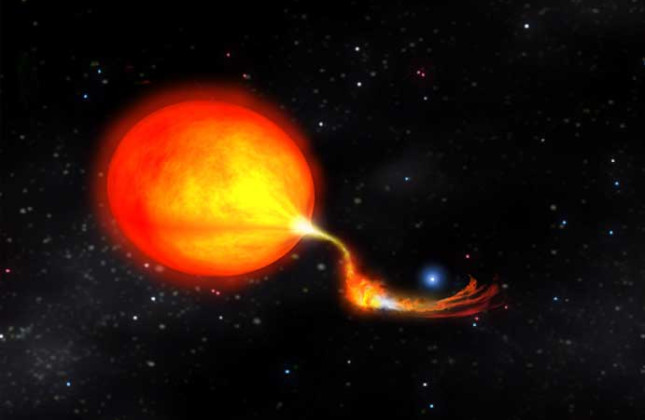Today I’d like to tell a brief story and discuss three recent papers accepted or submitted to The Astrophysical Journal & The Astrophysical Journal Letters (and make some self-promotion as I’ve been involved in writing two such papers). The story is about an extraordinary object, called PSR J1023+0038, or the “Missing Link Binary Pulsar”, and the three papers I’d like to talk about are recent works on this pulsar.
PSR J1023+0038 was discovered as a radio millisecond pulsar back in 2007 by A. M. Archibald and collaborators who promptly realized that this object had already been observed at optical wavelengths back in 2000-2001. In 2007 the radio pulsar appeared as a standard binary millisecond pulsar, with a neutron star (spinning around its rotational axis in just 1.7 milliseconds) bound to a normal star (a bit lighter than our Sun) and orbiting around it in about 5 hours. However, in the 2000-2001 optical observation it was found evidence for the presence of an accretion disk, which is the hallmark of another type of object, the low mass X-ray binaries. However, we know that millisecond radio pulsars and low mass X-ray binaries are very different objects, so PSR J1023+0038 had a transformation from a low mass X-ray binary into a radio millisecond pulsar somewhere between 2001 and 2007. This has been an extraordinary discovery because PSR J1023+0038 has been the first object to fill the evolutionary gap between the low mass X-ray binaries and radio millisecond pulsars. But why there was a gap in the first place and why is PSR J1023+0038 so extraordinary?
It is known that newborn neutron stars spin at a much lower rate, about once per second and to reach these extraordinary short periods of the order of milliseconds they need to be spun up by something. It was originally suggested that the spin up is provided by the gas stripped off the outer layers of a normal star that then accretes onto the neutron star, transfers its angular momentum and spins the neutron star up. This is not dissimilar to what happens to the wheel of a watermill accelerated and set in rotational motion by the flowing water.
Many indirect confirmations of this had been collected in the past years, but the “missing link”, i.e., a low mass X-ray binary switching to a radio millisecond pulsar, was yet to be found. Now, this is important because finding such an object can tell you how the accretion process stops, how the neutron star is spun up and what are the last phases of the evolution of the binary.
PSR J1023+0038 was monitored in radio since 2007 and the story continues with no further showstopper until June 2013. A group of astronomers based in the Netherlands (ASTRON, Leiden University), UK (University of Manchester), Canada (McGill University) and US (Columbia, Caltech and Stanford) discovered that this object had a new transition from a radio millisecond pulsar to a low mass X-ray binary. Radio pulsations disappeared abruptly, a new accretion disk appeared and an anomalous and yet unexplained increase in gamma ray emission was observed with the Fermi Gamma Ray Space Telescope.
After more than 5 months PSR J1023+0038 seems to be still in the same intriguing low mass X-ray binary state, but its luminosity is extremely low, suggesting that something strange is happening that prevents the gas in the disk from falling onto the neutrons star surface. Thanks to a long term radio monitoring carried from 2007 until 2013, Anne Archibald and collaborators have measured the spin and orbital variations of this object. New surprises came from this work as they found that the companion star is being evaporated at a high rate by the particles and radiation coming from the pulsar and that the companion star shows evidence for magnetic activity even if this is contrary to standard binary and stellar evolution.
What will come next is still an open question but it is certainly possible that PSR J1023+0038 will show new exciting and unexpected evolutionary processes and it will keep contributing to out understanding of how neutron stars evolve in binaries and become some of the most extreme objects in the Universe: millisecond pulsars.
(The blog descriptions of the discovery and X-ray follow-up of this system in quiescence can be read on Anne Archibald’s blog).
